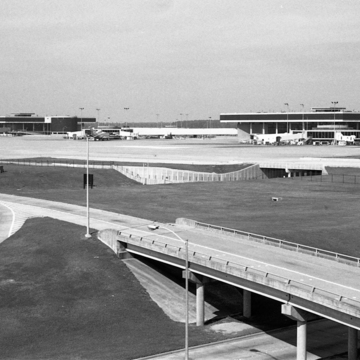You are here
George Bush Intercontinental Airport (Houston Intercontinental Airport)
Houston Intercontinental Airport (IAH) joined the Astrodome ( HN7) and the Galleria ( HN7) as one of the key Houston monuments that summed up the energy, vision, and contradictions of the 1960s. Planned and built over a seven-year period, the first phase of the complex (Terminals A and B and the Airport Hotel—the latter by William B. Tabler and Associates) stretches out along an east–west line to absorb and redirect the streams of traffic— planes, cars, pedestrians—that feed into them. The terminals were designed as articulated diagrams of the circulation patterns they contain and direct, producing dignified, generously scaled, easily negotiable public spaces. IAH was conceived as infrastructure as much as it was a collection of buildings, which made the architectural quality of materials, detailing, and construction seem even more impressive. This impression stems, in part, from an inescapable contrast between what Houston architects achieved in the 1960s with what occurred in the late 1990s and early twenty-first century. The reconstruction of these terminals to serve much larger volumes of passenger traffic has systematically diminished the quality of public space, disrupted patterns of circulation, effaced architectural finishes, and dumbed down the spatial authority of an imposing yet welcoming city gateway. It is the twenty-first-century equivalent of installing dropped acoustical ceilings and fluorescent lights in grand Beaux-Arts train stations. Terminal C of 1982 by Golemon and Rolfe Associates and Pierce Goodwin Alexander, although designed to be much larger than A and B to accommodate its tenant, Continental Airlines, preserves the architectural ethos of the original terminals. Houston infrastructure expert Christof Spieler predicts, on the basis of the Houston Airport System's master plan of 2005, that everything pre-1990 will eventually be demolished so that IAH's 1960s diagram can be replaced with a totally different twenty-first-century diagram. In this disregard for continuity, IAH is a quintessentially Houston place.
Writing Credits
If SAH Archipedia has been useful to you, please consider supporting it.
SAH Archipedia tells the story of the United States through its buildings, landscapes, and cities. This freely available resource empowers the public with authoritative knowledge that deepens their understanding and appreciation of the built environment. But the Society of Architectural Historians, which created SAH Archipedia with University of Virginia Press, needs your support to maintain the high-caliber research, writing, photography, cartography, editing, design, and programming that make SAH Archipedia a trusted online resource available to all who value the history of place, heritage tourism, and learning.















